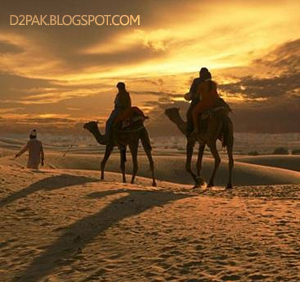 [K2 [above] is the 2nd largest peak in the world]
[K2 [above] is the 2nd largest peak in the world]
Pakistan is home to mountains, deserts, forests, hills, and plateaus. The different types of natural features range from the sandy beaches, lagoons, and mangrove swamps of the southern coast to preserved beautiful moist temperate forests and the icy peaks of the Himalaya, Karakoram and Hindu Kush mountains in the north. Northern Pakistan is mostly mountainous and has a vast amount of natural beauty that attract large number of tourists every year. While in the south, the west of the Indus are the dry, hilly deserts of Balochistan; to the east are the rolling sand dunes of the Thar Desert. The Tharparkar desert in the southern province of Sindh, is the only fertile desert in the world. Most areas of Punjab and parts of Sindh are fertile plains where agriculture is of great importance. The climate varies as much as the scenery, with cold winters and hot summers in the north and a mild climate in the south, moderated by the influence of the ocean. The wide variety of landscapes and climates in Pakistan allows for a wide variety of wild animals and birds. The forests range from coniferous alpine and subalpine trees such as spruce, pine, and deodar cedar in the northern mountains to deciduous trees such as the mulberry-type Shisham in the Sulaiman range in the south. The western hills have juniper and tamarisk as well as coarse grasses and scrub plants. Along the coast are mangrove forests which form much of the coastal wetlands. In the south, there are crocodiles in the murky waters at the mouth of the Indus River whilst on the banks of the river, there are boars, deer, porcupines, and small rodents. In the sandy scrublands of central Pakistan are found jackals, hyenas, wild cats, panthers, and leopards while the clear blue skies abound with hawks, falcons, and eagles. In the southwestern deserts are rare Asiatic cheetahs. In the northern mountains are a variety of endangered animals including Marco Polo sheep, Urial sheep, Markhor and Ibex goats, black and brown Himalayan bears, and the rare Snow Leopard. Another rare species is the blind Indus River Dolphin of which there are believed to be about 1,000 remaining, protected in two major sanctuaries. In recent years the number of wild animals being killed for fur and leather trading led to a new law banning the hunting of wild animals and birds and the establishment of several wildlife sanctuaries and game reserves.
Caught Between a Rock and an Immigrant Identity
15 years ago














0 comments:
Post a Comment